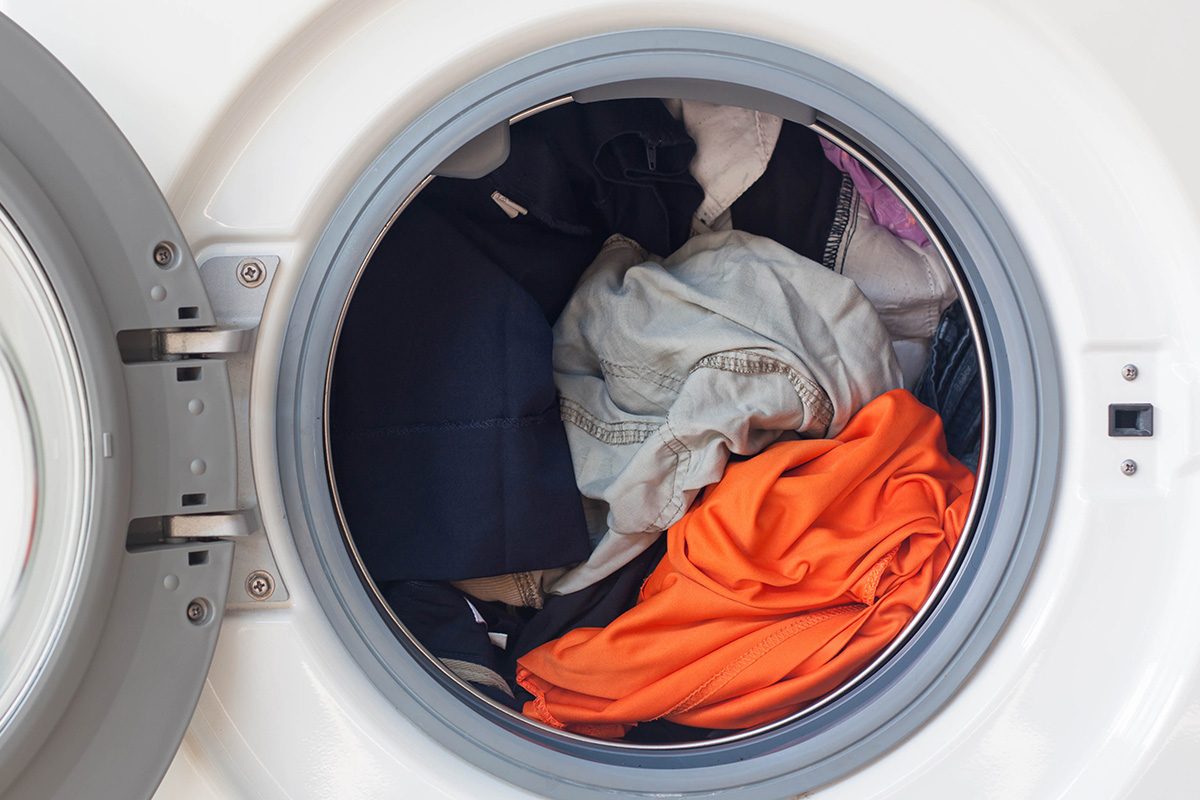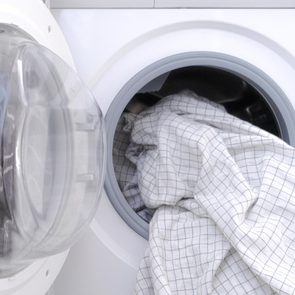It might be longer than you think!

Here’s How Long It’s OK to Leave Wet Clothes in the Washing Machine Before You Have to Rewash Them

You’re feeling pretty great about fitting in a load of laundry despite your hectic day until it hits you, hours later: Your clothes are still in the washing machine. Ugh. The struggle is real. If you think your next move is to redo the wash, you might be right—although it all depends on how long those soggy clothes have been sitting there in the first place.
So how long do you have before that awful musty smell emanates from your clothes and other icky things start to happen? I reached out to a microbiologist and a couple of laundry experts to find out.
Read on to learn what happens when you leave your wet clothes in the washing machine for too long—and how long you can leave them in there before you really need to run another cycle.
Get Reader’s Digest’s Read Up newsletter for more cleaning, travel, tech, humor and fun facts all week long.
What’s the maximum time you can leave wet clothes in the washing machine?
The buzz on #CleanTok and Instagram is that you have a window of 12 hours before you have to tumble those forgotten clothes in a second wash cycle. However, you might stretch it even longer, up to 24 hours, says Jill Roberts, PhD, an associate professor in environmental health microbiology at the University of South Florida College of Public Health.
Bacteria need something to feed on, Roberts says, and in a lab setting under “perfect conditions” (meaning it’s warm and there’s a food source), bacteria will start to grow in 16 hours. But that’s under perfect conditions, not the inside of your washer, where a lot—though not all—of the bacteria and other microbes will be killed off in the soap and water.
Still, there is mold growth to contend with, and the moist, warm environment of the washer will make mold “happy,” says Roberts. But mold growth isn’t immediate, nor does it take just a few hours, which is why Roberts doubles that 12-hour time frame. “Within about 24 hours, we’ve got some pretty good [mold] growth going,” she says.
Can this bacteria and mold harm you?
Typically, there’s nothing to worry about, even if bacteria does start to grow. “There’s no good route of spread [from] clothing to infection,” says Roberts, who also assures us that we (hopefully) aren’t eating our clothes or making a sandwich on them, which would possibly accelerate that route of spread.
If you have bad allergies, you’ll likely be triggered by the mold and allergens found outside, not by what’s growing in your washing machine, she adds. “Your washing machine is growing the same old stuff we see in the bathroom,” she explains. That might still be gross, but it’s not the same type of black mold growth that pops up after a house flood. In fact, any mold that might be growing in your washer is “unlikely to be very dangerous,” Roberts says.
What happens if you leave clothes in the washer for too long?
As you probably know from personal experience, your clothes will give off a gross, musty odor. That’s why Melissa Dilkes Pateras, a popular laundry expert on TikTok and the author of A Dirty Guide to a Clean Home: Housekeeping Hacks You Can’t Live Without, suggests doing your best not to go past the 12-hour mark. “I think that’s getting pretty dicey when you’re up to the 24-hour mark.” The bottom line? If you get a whiff of mustiness when you open the door, it’s been too long.
Roberts agrees. “If I open up that washing machine and those clothes stink, there’s a problem,” she says.
That said, sometimes you can eke out a little extra time beyond that 12-hour mark. For example, says Pateras, if your laundry load wasn’t that dirty to begin with, “obviously it’s not holding on to a ton of bacteria,” and if your clothes were set to a cycle that allowed for an extra rinse, then you’ve got some more flexibility. Plus, the quality and quantity of the laundry detergent you used along with any bleach you might have added can also extend the time frame.
What should you do if you pass this time limit?

Feel free to yell a bit, or maybe even shake an angry fist at the sky (or rather, the ceiling of the laundry room) when you’ve realized your gaffe. But then, it’s time to take action. Fortunately, there shouldn’t be much more to do than just rewash the clothes, using the same amount of detergent as before. You don’t even have to take them out of the machine, Pateras says, unless you want to stink up the whole laundry space.
However, she does suggest a few options to ensure this second wash gets rid of any musty smells:
- Choose the presoak option. Most new machines have this option; if yours does, use it. “It just adds soaking time to the start of the cycle,” says Pateras.
- Add a laundry booster. Baking soda, laundry soda or borax are the main laundry boosters to consider, according to Pateras. A 1/2 cup of baking soda added to the washer drum should do the trick; follow the directions on the box of the laundry soda or borax you use.
- Add a fabric rinse aid. You could choose a commercial product, like Downy Rinse & Refresh, or add some distilled white vinegar to the fabric-softener dispenser.
Warning: Never use vinegar with bleach. The combination creates toxic fumes.
What should you do if another wash doesn’t remove the musty smell?
A second wash cycle should do the trick, but if not, your clothes might need a longer soak to remove any dank smells that remain.
“If [the laundry is] still musty, which is pretty unlikely, then soak the laundry in cool water with 2 cups of distilled white vinegar for a few hours and then wash again,” says Logan Taylor, president of the Dazzle Cleaning Company.
Again, vinegar is a natural way to soften fabrics and neutralize odors. But if you suspect the musty smell is coming from your washing machine, then it might be time to wash your washing machine.
Do you need to clean your washing machine after leaving laundry in for too long?
It’s not always necessary to wash your washing machine after leaving wet clothes in it, especially if you don’t detect any bad smells. However, if you smelled something funky that prompted another wash for that forgotten load and you still detect an odor afterward, then it’s time to clean the washer.
Roberts says washing machine tablets do the job well. Just make sure to use the “clean” setting on your machine to get it up to the high heat it needs to wash the machine.
If you don’t have any tablets on hand, there’s another more natural solution, says Taylor. Add a couple of drops of dish soap and a cup of white distilled vinegar to the washer—no laundry—and run a wash cycle.
What are some good tricks to ensure you don’t forget your laundry?
Of course, you can mark most of this discussion as moot if you just remember to get your laundry out of the wash in the first place. But I’ll attest that it’s super easy to forget. So in the interest of saving time, energy and laundry supplies, it’s a good idea to find ways to stay on top of this. Here are a few smart tricks that you’ll hopefully turn into lifelong habits:
- Set a reminder. “If you’re prone to forgetting your laundry, set a timer on your phone, or tie a little string around your finger to remind yourself to get the laundry,” says Taylor. The latter is certainly old-school, but it works.
- Activate the alert on your washing machine. Pateras says to take advantage of the end-of-cycle alert function on your washer. “I know it’s annoying,” she admits, but do turn it back on or raise the volume level so you can actually hear the signal. For those with smart machines, ensure any push alerts are active on your phone or tablet.
- Stay close by. Keeping within close proximity to your washer while it’s working is helpful, but not always feasible. That’s where the delay function on your machine can work wonders, says Pateras … as long as you set it for a time that won’t result in your clothes being stuck in the dryer, of course.
About the experts
|
Why trust us
At Reader’s Digest, we’re committed to producing high-quality content by writers with expertise and experience in their field in consultation with relevant, qualified experts. We rely on reputable primary sources, including government and professional organizations and academic institutions as well as our writers’ personal experiences where appropriate. We verify all facts and data, back them with credible sourcing and revisit them over time to ensure they remain accurate and up to date. Read more about our team, our contributors and our editorial policies.
Sources:
- Jill Roberts, PhD, associate professor of environmental health microbiology at the University of South Florida College of Public Health; phone interview, March 6, 2025
- Melissa Dilkes Pateras, author of A Dirty Guide to a Clean Home: Housekeeping Hacks You Can’t Live Without; phone interview, March 7, 2025
- Logan Taylor, president of the Dazzle Cleaning Company; email interview, March 7, 2025























